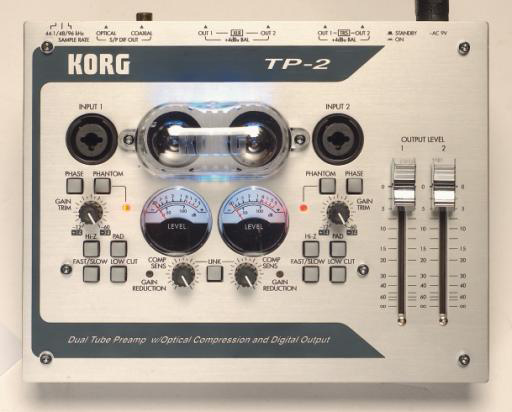MusicRadar Verdict
A handy tool giving a clean and precise sound for your recording.
Pros
- +
Nice sounding preamp. Powerful compressor. Useful digital output.
Cons
- -
Compressor lacks controls. Shiny silver fader caps look tacky.
MusicRadar's got your back


A soundcard or audio interface exists to get sound into (and out of) a computer, but unless that interface is a sophisticated affair equipped with an onboard preamp you can't plug a microphone or guitar straight in: an external preamp of some form is needed. That preamp could simply be part of a mixing desk channel or it could be a standalone unit, many of which are available with onboard tone shaping and compression facilities.
The TP-2 from Korg is such a unit. It is a preamp with two (stereo linkable) mono channels that is equipped with a pair of valves to add some of that old valve mojo to the sound. Whether that mojo be interpreted as extra warmth, a fatter sound or a pleasant touch of distortion, the general perception is that some valves in the signal chain can certainly enhance and improve that signal.
Add to that an integral optical compressor and you have a unit that should not only enable you to record quality audio but one that may also be used at other points in an audio signal chain as a sound enhancer.
Build
The TP-2 is a curious looking but solidly built metal box that sits on a flat surface with the pair of valves standing proud beneath a hard plexiglass protective bubble. All of the outputs, analogue and digital, are on the unit's rear edge. But to get signal into either one of its two channels you have a pair of combo sockets on the top surface that can take signal from an XLR mic cable or a balanced or unbalanced jack for signals from both line level equipment and from guitars. Each channel has a switch to provide phantom power for condenser mics and a Hi-Z switch to set the socket's impedance so it can take a signal directly from a guitar.
All the usual control elements found on a mixing desk input channel are here - phase reverse, pad switch, low cut filter and input gain knob - and a pair of circular VU meters show the input signal level.
To bring the compression into play, each channel has a rotary knob to set the sensitivity. Turning these clockwise from the off position effectively turns up the amount of compression. Only one other parameter is adjustable - the compressor response speed which can be switched to fast (for more percussive sounds) or slow (for more sustained sounds). A pair of faders control the analogue audio output.
Want all the hottest music and gear news, reviews, deals, features and more, direct to your inbox? Sign up here.
Sounds
Plugging a guitar or mic straight in to record a signal directly to a computer you have the option of using the TP-2 analogue outputs into your soundcard's line inputs, or using the digital output into a soundcard's digital inputs. The digital output level is controlled by the juxtaposition of the input gain and compression knobs rather than the level faders and, as it's those two knobs that have the most affect on altering the sound, the digital method is a touch less versatile.
With normal amounts of gain the sound is as clean and precise as you'd expect from a decent preamp, and quality results are easily attained using a condenser mic to record an acoustic guitar or vocals with a little added compression nicely thickening up the sound as needed.
Clean electric guitar sounds really good recorded directly through this unit - the valves making the guitar sound less sterile than you would get with a standard DI box. Turning up the gain knob further does get the valves cooking and you can get quite a bit of distortion happening.
We're not talking overdriven Marshall, but there is enough crunch for recording mildly distorted guitar and adding extra authenticity when software amp simulation plug-ins like Amplitube and Guitar Rig are applied. Dialling in some compression squashes the sound to cut down the output gain but you have to use it with care as it's only the milder settings that really suit electric guitar.
Direct recording into a computer isn't the only useful application for the TP-2, it can be used in the same role with a hardware studio for a different flavour of sound that may be an improvement over the built-in preamps. It could also add a touch of real valve sound to the digital signal of a POD, or be used as a mastering compressor/enhancer to give a bigger sound to a stereo mix from whatever recorder you are using.
Verdict
If you record microphone signals into a computer you definitely need a mic preamp in the signal chain, and one with built-in valve sound and optical compression obviously makes sense if you are looking for a bit of pleasant signal enhancement. Overall, the TP-2 is a very useful tool that can help you make better recordings.
MusicRadar is the number 1 website for music makers of all kinds, be they guitarists, drummers, keyboard players, djs or producers...
GEAR: We help musicians find the best gear with top-ranking gear round-ups and high- quality, authoritative reviews by a wide team of highly experienced experts.
TIPS: We also provide tuition, from bite-sized tips to advanced work-outs and guidance from recognised musicians and stars.
STARS: We talk to musicians and stars about their creative processes, and the nuts and bolts of their gear and technique. We give fans an insight into the actual craft of music making that no other music website can.
